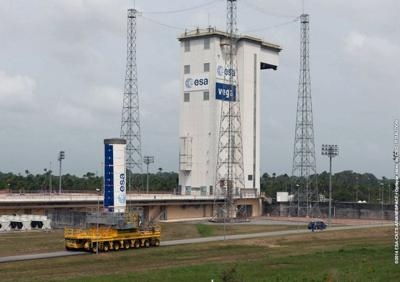Wed, Feb 19, 2014
Payload Will Be A Satellite For The Republic Of Kazakhstan
The launcher for Arianespace’s initial Vega flight of 2014 began its build-up this week at the Spaceport in French Guiana, marking the first step in a mission campaign that will lead to its orbiting of the DZZ-HR high-resolution observation satellite. To initiate the activity, Vega’s P80 first stage was transferred yesterday from the Spaceport’s Booster Integration Building to the SLV launch zone. It was then positioned on the launch pad and protected by the mobile gantry.

The P80 is an advanced solid propellant motor that features a novel filament-wound casing structure. Using one of the largest, most powerful single-block solid propellant motors ever built, the 33-foot tall stage burns for approximately 100 seconds during Vega’s first phase of flight.
This third Vega mission’s DZZ-HR payload is a satellite produced by Airbus Defense and Space for the Republic of Kazakhstan’s government. Once in Sun-synchronous orbit, DZZ-HR will provide very-high-quality panchromatic and multispectral products for a wide range of applications, including cadastral surveys, management of natural resources, environmental monitoring and homeland surveillance.
Vega is the light-lift member of Arianespace’s launcher family, joining the medium-weight Soyuz and heavy-lift Ariane 5 in operations at the Spaceport. Developed in a European Space Agency program led by Italy’s ASI space agency and industrial prime contractor ELV SpA., Vega was conceived for the orbiting of small- to medium-sized satellites, including institutional and scientific spacecraft.
The first Vega launch (designated Flight VV01 in Arianespace’s numbering system) was a qualification mission performed in February 2012, carrying the LARES laser relativity satellite, a small ALMASat-1 technology microsatellite demonstrator, and seven CubeSats. It was followed by Flight VV02 in May 2013, which orbited the Proba-V, VNREDSat-1 and ESTCube-1 satellites.
(Image provided by Arianspace)
More News
Aero Linx: Model Aeronautical Association of Australia MAAA clubs are about fun flying, camaraderie and community. For over 75 years, the MAAA has been Australia’s largest fl>[...]
Touchdown Zone Lighting Two rows of transverse light bars located symmetrically about the runway centerline normally at 100 foot intervals. The basic system extends 3,000 feet alon>[...]
“Discovery and innovation are central to our mission at Virgin Galactic. We’re excited to build on our successful record of facilitating scientific experiments in subor>[...]
How To Get A Story On Aero-TV News/Feature Programming How do I submit a story idea or lead to Aero-TV? If you would like to submit a story idea or lead, please contact Jim Campbel>[...]
Student Pilot Reported That During Rotation, “All Of A Sudden The Back Of The Plane Kicked To The Right..." Analysis: The student pilot reported that during rotation, “>[...]
 ANN's Daily Aero-Linx (05.02.24)
ANN's Daily Aero-Linx (05.02.24) ANN's Daily Aero-Term (05.02.24): Touchdown Zone Lighting
ANN's Daily Aero-Term (05.02.24): Touchdown Zone Lighting Aero-News: Quote of the Day (05.02.24)
Aero-News: Quote of the Day (05.02.24) ANN FAQ: Contributing To Aero-TV
ANN FAQ: Contributing To Aero-TV NTSB Final Report: Cirrus Design Corp SR20
NTSB Final Report: Cirrus Design Corp SR20



